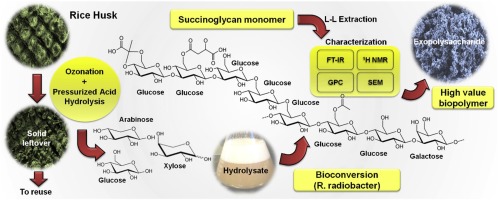Industrial Crops and Products ( IF 5.6 ) Pub Date : 2019-05-30 , DOI: 10.1016/j.indcrop.2019.05.052 Giovanni B. Pedroso , Leandro O. Silva , Raiara B. Araujo , Loisleini F. Saldanha , Laura Denardi , Ayrton F. Martins

|
Rice husk (RH) was submitted to ozonation followed by pressurized acid hydrolysis with the aim of reducing the lignocellulosic recalcitrance and freeing the fermentable monosaccharides from cellulose and hemicellulose. The hydrolysate was then detoxified and used as a fermentative substrate for the production of succinoglycan biopolymer, which is an exopolysaccharide. The use of pH 7.0, and 25% RH (w v−1) solution, and the effects of ozonization for 60 min (1.5 g h-1 de O3), made the lignocellulosic matrix more susceptible to subsequent pressurized acid hydrolysis (2.5% H2SO4 w v−1, 45 min treatment, 145 °C), and produced up to 16.1 g sugars L-1. Detoxification with activated carbon (4.0% v v-1, 60 min, 80 °C) reduced the inhibition and made the broth more fermentable. The Rhizobium radiobacter (LMG196 and ATCC4720) then produced 69.0 g succinoglycan L-1 under optimized conditions. Once extracted (91.2% purity) and characterized (FT-IR, NMR, GPC and SEM), this led to a new set of results that were better than those found in the literature, since they included the exploitation of the left-over biomass for the production of a valuable exopolysaccharide (41.6 g 100 g-1 RH). The unconstrained multivariate optimization allied to the RH ozonation strategy, followed by pressurized acid hydrolysis, gave rise to promising yields, which confirms the technical viability and the innovative feature of succinoglycan production.
中文翻译:

从稻壳生物技术生产琥珀聚糖的创新方法
稻壳(RH)经过臭氧化处理,然后进行加压酸水解,目的是减少木质纤维素的顽固性并从纤维素和半纤维素中释放出可发酵的单糖。然后将水解产物解毒并用作生产琥珀聚糖生物聚合物(一种胞外多糖)的发酵底物。pH 7.0和25%RH(wv -1)溶液的使用以及臭氧化作用60分钟(1.5 gh -1 de O 3)的影响,使得木质纤维素基质更容易受到随后的加压酸水解(2.5%H)的影响。2 SO 4 w v -1,在145°C下处理45分钟),最多可产生16.1 g糖L -1。解毒用活性炭(4.0%VV -1,60分钟,80℃)降低了抑制并把肉汤更发酵。然后,在优化条件下,根瘤菌(LMG196和ATCC4720)产生了69.0 g琥珀糖基L -1。提取后(纯度为91.2%)并进行了表征(FT-IR,NMR,GPC和SEM),这导致了一组新的结果,优于文献中的结果,因为它们包括了对剩余生物质的利用。用于生产有价值的胞外多糖(41.6 g 100 g -1RH)。与RH臭氧化策略相关联的无限制多元优化,然后进行加压酸水解,产生了可观的收率,这证实了琥珀聚糖生产的技术可行性和创新性。





















































 京公网安备 11010802027423号
京公网安备 11010802027423号